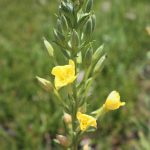Common evening primrose
Prepared by Jennifer L. D’Appollonio, Assistant Scientist, University of Maine, Orono, ME 04469. Updated April 2019.
Scientific name: Oenothera biennis L.
Common name(s): common evening primrose, evening star, King’s cure-all
Links: USDA PLANTS Profile, NPIN Profile, Go Botany
Images: (to see enlargements [PC]: click on image, then right click and choose “view image”)
- in flower, July
- leaf detail
- in poor growing conditions
- early flower
- flower detail
- often host to the primrose moth
Description:
– biennial
-herbaceous forb
-flowers open in the evening
-yellow to gold corolla is 2-5 cm wide, with four petals
-leaves are
- basal
- 10-30 cm long
- stem leaves are alternate and lanceolate
- hairy
– generally flowers July to September in ME
– may be confused with O. parviflora or O. villosa; see left sidebar of Go Botany webpage
Habitat:
-full sun
-dry open fields
-roadsides
-woods
Agriculture:
-attracts humming birds
-the seed capsules provide food
Natural History:
-used by the Cherokee, Iroquois, Ojibwas, and Potawatomi Native American Tribes
– the young leaves and shoots are edible
-the roots were chewed and rubbed onto the muscles to improve strength
-used to treat pain associated with menstruation as well as bowel pain
Source(s):
Heinrich, B. 1976. Flowering phenologies: Bog, woodland, and disturbed habitats. Ecology. 57(5):890-899.
Immel , Dianna L. “COMMON EVENING-PRIMROSE Oenothera Biennis L. .” Plant Fact Sheet , USDA, NRCS, National Plant Data Center, c/o Environmental Horticulture Department, University of California, Davis, California , June 2001, plants.usda.gov/plantguide/pdf/cs_oebi.pdf.











